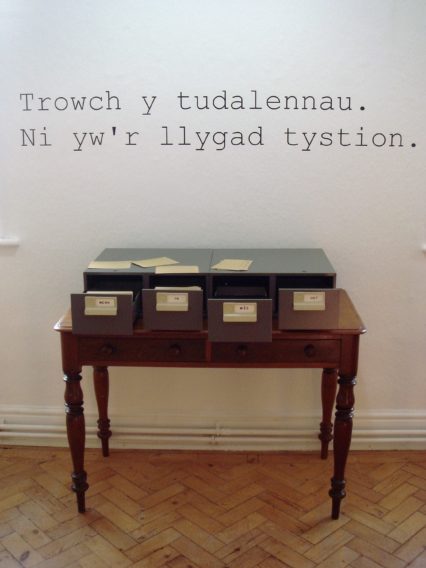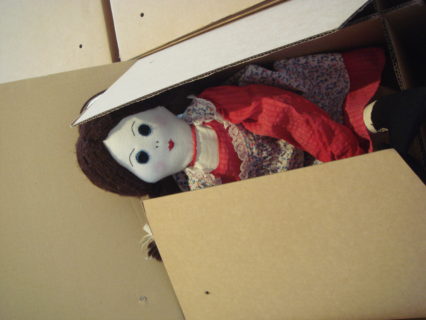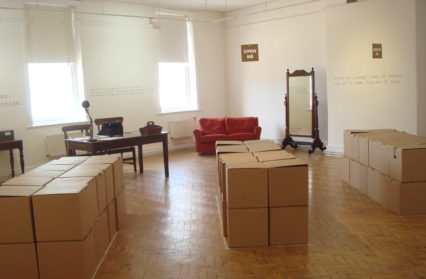Ceredigion Museum
 “Agor Fi” – “Open Me”, that tantalizing invitation dangling above the cardboard boxes seems to come straight out of Alice in Wonderland. And, indeed, just like Alice delves into the rabbit hole and explores her new and strange surroundings, visitors at Ceredigion Museum are encouraged to delve into the boxes and investigate their content, to go on a search for memories and stories. As Curator Carrie Canham disclosed on the opening night of ‘Hollow: Mining for Stories’: “To me a cardboard box is about the discovery of what’s inside.” Guests on the evening were certainly of the same opinion and enthusiastically participated. A young woman was wandering around all by herself, but was not too shy not to open a box or two, pulling out objects and holding them up for closer inspection. Old dolls, books, postcards or household appliances came to light, and comments such as “Remember having one of these?” were buzzing around the room. Some people had no idea what their finds were and curiously tried to make sense of it, often referring to the provided object list for illumination. One wooden tool baffled everybody present, until a boy pragmatically decided that it was for “Knocking out people.” In the meantime, the riddle has been solved: it seems to be a marking gauge.
“Agor Fi” – “Open Me”, that tantalizing invitation dangling above the cardboard boxes seems to come straight out of Alice in Wonderland. And, indeed, just like Alice delves into the rabbit hole and explores her new and strange surroundings, visitors at Ceredigion Museum are encouraged to delve into the boxes and investigate their content, to go on a search for memories and stories. As Curator Carrie Canham disclosed on the opening night of ‘Hollow: Mining for Stories’: “To me a cardboard box is about the discovery of what’s inside.” Guests on the evening were certainly of the same opinion and enthusiastically participated. A young woman was wandering around all by herself, but was not too shy not to open a box or two, pulling out objects and holding them up for closer inspection. Old dolls, books, postcards or household appliances came to light, and comments such as “Remember having one of these?” were buzzing around the room. Some people had no idea what their finds were and curiously tried to make sense of it, often referring to the provided object list for illumination. One wooden tool baffled everybody present, until a boy pragmatically decided that it was for “Knocking out people.” In the meantime, the riddle has been solved: it seems to be a marking gauge.
Assistant Curator Alice Briggs explains that the objects are taken from the museum’s handling collection. Opposed to the artefacts in the permanent collection, she says: “A handling collection is really different, because they are our ‘forgotten objects’; their social history and information about how they are connected with Ceredigion are lost. So it’s really nice that these objects come into a space where they’re rediscovered, create new stories. They also had to come from our handling collection because we couldn’t be using objects from the main collection, because a) we don’t touch those [due to their value and/or fragility] and b) it’s not an invigilated space so people could just walk off with them.”
She expounds further that a lot of clothes, such as gloves, hats and aprons were chosen as visitors, once realising that the usual “don’t touch” scenario at museum exhibitions doesn’t apply here, become very playful, enjoy dressing up in them and taking photos. As Dona Hayward, the museum’s Front of House and Retail Coordinator, remarks, she can often hear laughter coming out of the temporary gallery in which the exhibition is located. Most of the objects are day-to-day articles, again, a deliberate choice by the artist Jenny Hall and the curators, to enable the visitors to relate to them. What smells, feelings, fleeting recollections do the items elicit? What were they needed for? Who would have used them? Explorers are also asked to leave their thoughts and impressions on index cards, and a variety of comments have been left since the opening. Many of them are quite nostalgic, such as “memories of Sunday teatime” or “reminder of mother in her apron”, from a 77-year old lady. However, as Alice Briggs assures, the exhibition is also a great success with children, who simply see the books and playing cards and dolls as what they are: toys to be loved and played with. It is thus the visitors who breathe new life into these ‘forgotten objects’ and give them a new history – just what Briggs and Hall had envisioned.
 What is initially puzzling about the installation is that it appears very orderly; whoever imagines just a big jumble of endlessly piled-up cardboard boxes to dive right into will be disappointed. The sunlit gallery space rather looks a little like an example of how to create a modern, but ‘lived-in’-looking, middle-class home, taken from an interior design magazine. The white walls are adorned with citations from stories and poems in Welsh and English provided by the artist’s literary friends; the floor is parquet; and around the room are carefully placed comfy red sofas, an antique typewriter atop a wooden desk, an old-fashioned mirror and that set of card index boxes in which visitors can leave their observations. The light-brown cardboard boxes are laid out in three diagonal rows. The colour scheme is impeccable.
What is initially puzzling about the installation is that it appears very orderly; whoever imagines just a big jumble of endlessly piled-up cardboard boxes to dive right into will be disappointed. The sunlit gallery space rather looks a little like an example of how to create a modern, but ‘lived-in’-looking, middle-class home, taken from an interior design magazine. The white walls are adorned with citations from stories and poems in Welsh and English provided by the artist’s literary friends; the floor is parquet; and around the room are carefully placed comfy red sofas, an antique typewriter atop a wooden desk, an old-fashioned mirror and that set of card index boxes in which visitors can leave their observations. The light-brown cardboard boxes are laid out in three diagonal rows. The colour scheme is impeccable.
When questioned, Briggs elucidates that aesthetics played a great role: “We had an idea before we set up, but then you never really know how it works out until everything is in place. It’s about how people come into the space first. How does the lay-out influence them? We had the boxes initially going straight in two rows down the middle of the room. Then Stuart [Stuart Evans, Museum Designer] came in, talking about the herringbone line of the parquetted floor. Jenny thought that was great, so she aligned the boxes along the order of the herringbone pattern. Setting up the installation was very much about playing with the space, how it looked and how it felt.”
The careful design also makes sense when considering Jenny Hall’s background in architecture and her statement that she wanted “to create an installation that responded to different qualities I value in architecture: playful, adaptable, metaphorical and beautiful.” Health and safety issues also prevented staking boxes too high on top of each other. The collection catalogue and the manual also diminish that sense of adventure, but Briggs points out that not everybody is brave enough to interact with a museum installation without any guidance and the explicit permission to touch what would normally only be looked at behind glass or barriers.
The exhibition ‘Hollow: Mining for Stories’ is running at Ceredigion Museum in Aberystwyth until the 10th of July 2016. It forms part of Jenny Hall’s ‘Hollow’-project which is touring Wales until the end of August 2016. For more information, please refer here and to https://www.ceredigion.gov.uk/index.cfm?articleid=17460












